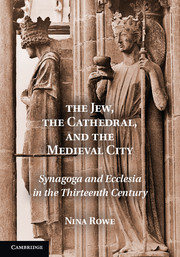Book contents
- Frontmatter
- Contents
- List of Illustrations
- Acknowledgments
- Abbreviations
- Introduction: The Jew, the Cathedral, and the Medieval City
- PART I IMAGINING JEWS AND JUDAISM IN LIFE AND ART
- PART II ART AND LIFE ON THE ECCLESIASTICAL STAGE – THREE CASE STUDIES
- Introduction to Part II: Nature, Antiquity, and Sculpture in the Early Thirteenth Century
- 3 Reims: “Our Jews” and the Royal Sphere
- 4 Bamberg: The Empire, the Jews, and Earthly Order
- 5 Strasbourg: Clerics, Burghers, and Jews in the Medieval City
- Epilogue: The Afterlife of an Image
- Notes
- Glossary
- Bibliography
- Index
5 - Strasbourg: Clerics, Burghers, and Jews in the Medieval City
Published online by Cambridge University Press: 05 January 2012
- Frontmatter
- Contents
- List of Illustrations
- Acknowledgments
- Abbreviations
- Introduction: The Jew, the Cathedral, and the Medieval City
- PART I IMAGINING JEWS AND JUDAISM IN LIFE AND ART
- PART II ART AND LIFE ON THE ECCLESIASTICAL STAGE – THREE CASE STUDIES
- Introduction to Part II: Nature, Antiquity, and Sculpture in the Early Thirteenth Century
- 3 Reims: “Our Jews” and the Royal Sphere
- 4 Bamberg: The Empire, the Jews, and Earthly Order
- 5 Strasbourg: Clerics, Burghers, and Jews in the Medieval City
- Epilogue: The Afterlife of an Image
- Notes
- Glossary
- Bibliography
- Index
Summary
On January 20, 1248, the canons of Strasbourg and members of the lay municipal council gathered in the south transept of their cathedral to confirm the dispensation of gifts to a local monastery. Strasbourg Cathedral's south transept had recently been rebuilt using novel architectural elements and was newly adorned at the interior and exterior with figures sculpted from the red sandstone of the Vosges mountains in vibrant au courant styles. The south façade of Strasbourg's transept was particularly decked out. Some elements of the ensemble here were removed in the wake of the French Revolution, but an engraving of 1617 by Isaac Brunn records the façade's original appearance (see Figs. 120-122). The tympana and lintels of the façade's double portal present scenes of the Virgin at her Dormition, surrounded by anguished followers, her funeral procession and ascension, and the culminating glory of her coronation by Christ as Queen of Heaven (Figs. 123-124). Twelve figures of apostles crowd into the jambs, attendants to the seated Solomon, enthroned atop a short column between the façade's double portals and beneath a bust of Christ (Fig. 125). This Solomon figure, like the images of rulers at Reims and Bamberg, and echoing antique conventions for the depiction of male authority, is accompanied by feminine figurations that attest to his power – personifications of Church and Synagogue, the former turning to look across the porch at her rival, the latter twisting away and lowering her head (Figs. 126-129).
- Type
- Chapter
- Information
- The Jew, the Cathedral and the Medieval CitySynagoga and Ecclesia in the Thirteenth Century, pp. 191 - 237Publisher: Cambridge University PressPrint publication year: 2011



